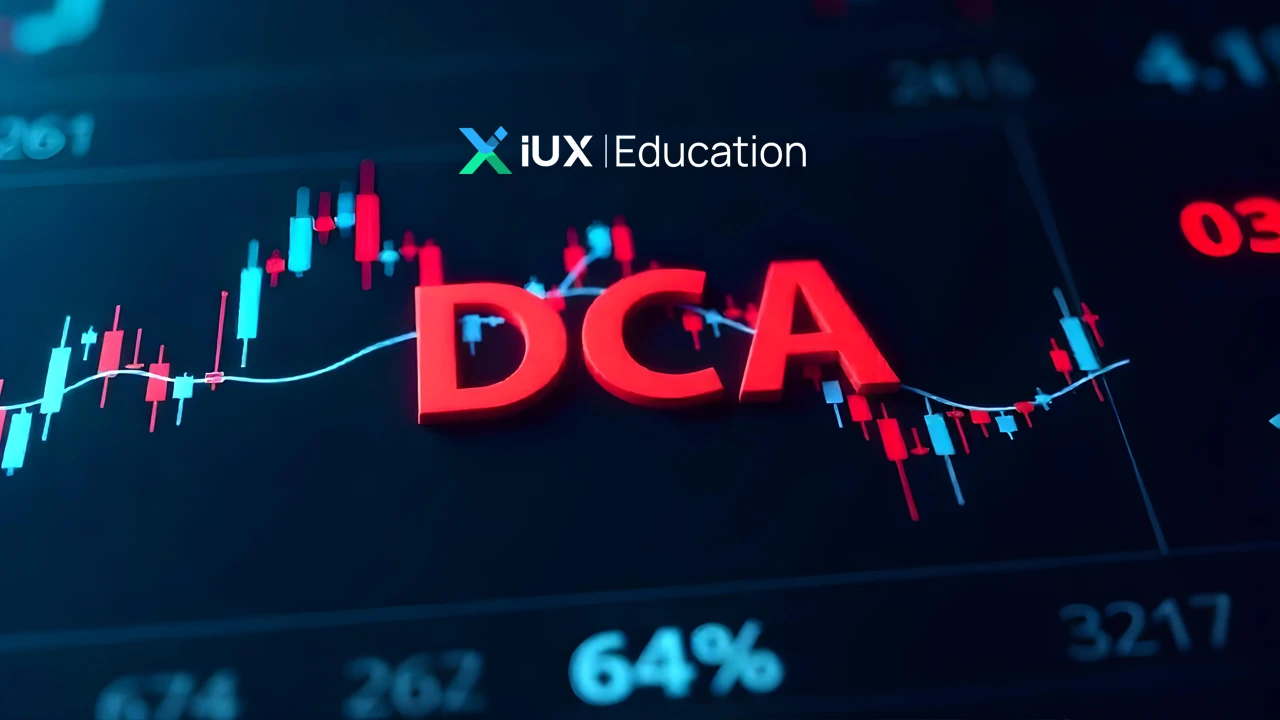CFDs are complex instruments and come with a high risk of losing money rapidly due to leverage. 76% of retail investor accounts lose money when trading CFDs with this provider. You should consider whether you understand how CFDs work and whether you can afford to take the high risk of losing your money.
CFDs are complex instruments and come with a high risk of losing money rapidly due to leverage. 76% of retail investor accounts lose money when trading CFDs with this provider. You should consider whether you understand how CFDs work and whether you can afford to take the high risk of losing your money.

DCA Performance Analysis Using 10-Year Historical Market Data
Analyzing the Returns of DCA Based on 10 Years of Market Data
Dollar-Cost Averaging (DCA) is a widely recognized investment strategy among long-term investors—especially when dealing with highly volatile assets like stocks. This strategy involves investing a fixed amount of money at regular intervals, regardless of market conditions. By doing so, investors reduce the risk of mistiming the market and build consistent investing habits.
This article takes a deep dive into the effectiveness of DCA when applied to global assets such as ETFs and major stock indices. Using actual historical data from 2014 to 2024, we’ll examine the potential returns investors could expect and explore how key global events over the past decade have impacted performance.
How We Collected the Data and Analyzed DCA Returns from Global Markets
The analysis in this article is based on historical data from major global stock indices: the S&P 500 (U.S. stock market), NASDAQ 100 (U.S. technology sector), MSCI World (developed markets globally), and MSCI Emerging Markets (emerging markets worldwide).
To ensure a clear and unbiased view, we simulated a Dollar-Cost Averaging (DCA) strategy with a consistent monthly investment of $100 (or equivalent) from January 2014 through December 2024. The number of units acquired each month was calculated based on end-of-month closing prices.
All data was sourced from credible providers, including official MSCI Index data and Yahoo Finance – Historical S&P 500.
By applying this long-term DCA strategy across global market indices, we can assess cumulative returns, volatility, and the overall effectiveness of DCA under various market conditions. 1
Analyzing DCA Returns in the S&P 500 (United States)
The S&P 500 Index consists of 500 leading companies in the United States and serves as a key benchmark for the U.S. equity market. Over the past decade (2014–2024), the U.S. stock market has gone through several major events, including the post-2008 financial crisis recovery, the COVID-19 pandemic in 2020, and the interest rate hikes by the Federal Reserve during 2022–2024.
Sample DCA Investment Performance in the S&P 500 (2014–2024)
-
Monthly investment: $100
-
Total invested over 10 years: $12,000
-
Portfolio value at the end of 2023: approximately $23,000
-
Cumulative return: 90%
-
Average CAGR: 7.5% per year
(Note: This CAGR may appear slightly lower than the average CAGR of the S&P 500 itself, as it's based on a DCA portfolio with continuous cash inflows rather than a lump sum invested upfront.)
Sample Lump Sum Investment Performance in the S&P 500 (2014–2024)
-
One-time investment: $12,000 (at the beginning of 2014)
-
Portfolio value at the end of 2023: approximately $32,500 – $33,000
-
Cumulative return: around 170% – 175%
-
Average CAGR: approximately 10.5% – 11% per year 2
Sample DCA Returns in MSCI World and MSCI Emerging Markets (2014–2023)
In addition to investing in the S&P 500, diversifying across different regional markets is also essential. The MSCI World Index represents developed markets globally, while the MSCI Emerging Markets Index covers emerging economies. Comparing DCA performance across these two indices helps illustrate the differences in investment outcomes between regions.
Developed markets like the U.S., Europe, and Japan (MSCI World) typically offer greater economic stability and more mature capital markets. In contrast, emerging markets such as China, India, and Brazil (MSCI Emerging Markets) tend to have higher economic growth potential but also come with greater volatility and risk factors.
MSCI World (Developed Markets):
-
Total invested: $12,000 ($100 per month)
-
Portfolio value at end of 2023: approximately $22,500 – $24,500
-
Cumulative return: approximately 87% – 104%
-
Average CAGR: approximately 7.0% – 8.0% per year
MSCI Emerging Markets (Emerging Markets):
-
Total invested: $12,000 ($100 per month)
-
Portfolio value at end of 2023: approximately $13,800 – $14,800
-
Cumulative return: approximately 15% – 23%
-
Average CAGR: approximately 2.0% – 3.0% per year
A comparison of DCA and Lump Sum investing across multiple markets clearly shows how DCA helps reduce risk during downturns. While Lump Sum investing can generate higher returns during prolonged bull markets, it also carries greater risk—especially if the investment is made when the market is at or near a peak. Additionally, Lump Sum investing requires a large upfront capital outlay, which may not be feasible for every investor.
Key events such as the COVID-19 pandemic in 2020—which triggered a sharp market decline—demonstrated the strengths of DCA. As asset prices fell, investors using DCA were able to acquire more units at lower prices. This helped their portfolios recover and grow more effectively when the market eventually rebounded.
Similarly, during the Federal Reserve’s interest rate hikes in 2022–2023, which brought volatility and market corrections, DCA continued to smooth out the cost basis of investments. This consistent approach proved valuable in managing risk and maintaining long-term growth potential.
Article you might be interested in :
Should You Use DCA in a Volatile Market? Pros and Cons of Dollar-Cost Averaging During Market Shifts
Lessons from the Global Landscape Over the Past Decade
The past decade (2014–2024) has been marked by major global events that significantly impacted financial markets worldwide. Understanding how these events influenced the effectiveness of the DCA strategy can help investors prepare for future uncertainties.
- COVID-19 Crisis (2020): Global stock markets plunged sharply in early 2020 but rebounded within months. DCA allowed investors to accumulate more units at lower prices during the downturn, which contributed to strong portfolio recovery as markets turned bullish again.
- Russia–Ukraine War (2022): This conflict sparked volatility in energy and commodity markets and escalated geopolitical tensions. While stock markets were affected in the short term, DCA enabled investors to continue investing steadily without the pressure of timing the market.
- Federal Reserve Rate Hikes (2022–2023): To combat high inflation, the Fed raised interest rates, causing market volatility and corrections. During this period, DCA once again proved effective in lowering the average cost of investments and maintaining disciplined long-term investing.
- Big Tech Rally (2020–2021): The explosive growth of large-cap tech stocks—especially during the pandemic—was a major driver of index performance. Since many indices have a heavy allocation to these companies, DCA investors also benefited from this tech-driven upswing.
The key takeaway from these events is that markets are inherently volatile and unpredictable. Committing to a consistent DCA strategy, even during turbulent times, remains a powerful approach to building long-term wealth.
No matter how the market moves—up or down—or how turbulent global events become, DCA remains a powerful strategy for building long-term wealth. Investing consistently during times of crisis often provides golden opportunities to accumulate assets at lower prices.
IUX is here to be your trusted partner on your investment journey.
Our platform is easy to use, secure, and offers a wide range of assets—including stocks, indices, ETFs, and gold—along with powerful analysis tools and 24/7 support from a team of professionals.
▶ Sign up with IUX today and take your DCA strategy to the next level with confidence—so you never miss an opportunity in any market cycle.
Who Is DCA in Global Markets Best Suited For?
Based on 10 years of historical data, Dollar-Cost Averaging (DCA) in international markets has proven to be an effective strategy—and one that fits a wide range of investors:
-
Long-Term Investors Without the Time to Time the Market
DCA eliminates the need to predict market direction—something even seasoned investors struggle with. By simply investing consistently every month, you stay in the game without stressing over market timing.
-
Those Looking to Diversify Globally
Investing in global indices and ETFs—such as VOO (S&P 500 ETF), QQQ (NASDAQ 100 ETF), VT (MSCI World All-Cap ETF), EFA (MSCI EAFE ETF – developed markets outside the U.S.), and EEM (MSCI Emerging Markets ETF)—allows investors to spread risk and tap into growth opportunities across different regions.
-
Investors Seeking to Build Financial Discipline
Making regular monthly investments helps build strong financial habits and guards against emotional decision-making, especially during market volatility.
Related Article :
Frequently Asked Questions (FAQ)
Q: If I start DCA into U.S. stocks today, is it too late?
A: Starting a DCA strategy in the U.S. stock market today is still a solid approach. While short-term volatility may occur, the market has historically shown long-term growth. DCA helps average out your purchase cost over time and reduces the risk of investing at a market peak.
Q: Which is better—DCA into the S&P 500 or MSCI World?
A: It depends on your investment goals and preferences. The S&P 500 focuses solely on U.S. equities, which tend to offer higher returns but are also more exposed to U.S.-specific risks. MSCI World, on the other hand, provides broader exposure to developed markets globally, reducing reliance on a single economy. If you’re looking for global diversification, MSCI World may be more suitable. But if you believe in the long-term strength of the U.S. economy, the S&P 500 remains a strong choice.
Q: How can Thai investors DCA into international stocks?
A3: Thai investors have several ways to DCA into foreign markets:
- Through Thai brokers offering international investments: Many local brokers now provide direct access to U.S. and global ETFs and stocks.
- Via international mutual funds: These are managed by professional fund managers and offer exposure to global markets with ease of access and local currency options.
- Using Robo-advisors: Some platforms offer automated DCA plans into global portfolios, allowing investors to diversify internationally with minimal effort.
DCA into global assets is now more accessible than ever for Thai investors, thanks to growing investment platforms and expanded financial services.
Note: This article is intended for preliminary educational purposes only and is not intended to provide investment guidance. Investors should conduct further research before making investment decisions.


